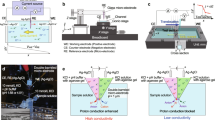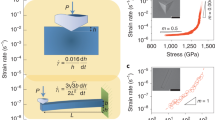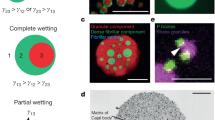Abstract
RECENTLY, it was found in this Institute1 that solutions of potassium hyaluronate give elastic recoil when examined in a glass capillary by the ‘œstroscope’ technique2. This was ascribed to the long, flexible hyaluronate ions, which presumably form a lace-work all through the solution, knitted together by hydrogen-bond cross-links and adhering to the glass wall. The potassium ions are obviously more free to move, but in flowing, as soon as they tend to run in advance of the negatively charged hyaluronate polyions, a potential must arise to preserve electroneutrality.
This is a preview of subscription content, access via your institution
Access options
Subscribe to this journal
Receive 51 print issues and online access
$199.00 per year
only $3.90 per issue
Buy this article
- Purchase on Springer Link
- Instant access to full article PDF
Prices may be subject to local taxes which are calculated during checkout
Similar content being viewed by others
References
Jensen, C. E., and Koefoed, J., J. Coll. Sci., [9, 460 (1954) ].
Scott Blair, G. W., et al., Biochem. J., 35, 1039 (1941).
Vilstrup, Th., and Jensen, C. E., Ann. Otology, Rhinology and Laryngology, 63, 151 (1954).
Wever, E. G., and Bray, C. W., Proc. U.S. Nat. Acad. Sci., 16, 344 (1930).
Author information
Authors and Affiliations
Rights and permissions
About this article
Cite this article
JENSEN, C., KOEFOED, J. & VILSTRUP, T. Flow Potentials in Hyaluronate Solutions. Nature 174, 1101–1102 (1954). https://doi.org/10.1038/1741101b0
Issue Date:
DOI: https://doi.org/10.1038/1741101b0
This article is cited by
-
Mechanoelectrical transduction, ion movement and water stasis in uromodulin
Experientia (1992)
-
Some features of the medium surrounding the mechano- and electroreceptors of the acousticolateral system of the ray Raja clavata
Neuroscience and Behavioral Physiology (1976)
-
Hexosamin in den Innenohrfl�ssigkeiten bei Mensch und Meerschweinchen
Archiv f�r Klinische und Experimentelle Ohren- Nasen- und Kehlkopfheilkunde (1968)
-
Displacement Potentials and Bending of Rod-like Polyelectrolytes
Nature (1961)
-
Mucosaccharides and glycoproteins
Ergebnisse der Physiologie Biologischen Chemie und Experimentellen Pharmakologie (1959)
Comments
By submitting a comment you agree to abide by our Terms and Community Guidelines. If you find something abusive or that does not comply with our terms or guidelines please flag it as inappropriate.



